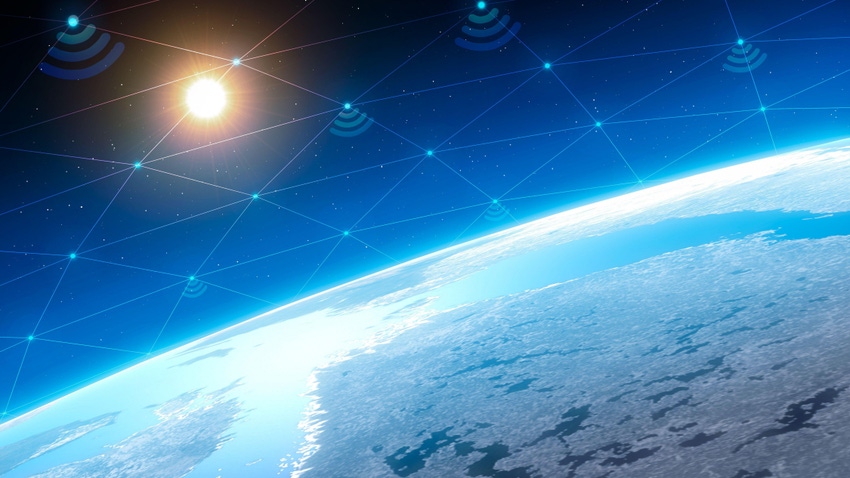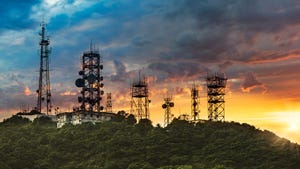April 8, 2024

Non Terrestrial Networks, which in a nutshell provide connectivity using satellites as opposed to terrestrial towers, have grown in significance in the last few years. The most obvious use case for using space-based equipment to hook a particular area up is where it would otherwise be hard or impossible to construct a tower, such as up a mountain or in the middle of the ocean. However as Intelsat pointed out in a recent interview with Telecoms.com, the sector is about more than just hard to reach areas.
One reason for more activity, investment and hype in the area is simply that it’s cheaper than it ever has been to send them into orbit, making them more viable as a business opportunity. But as well as filling gaps a network, telcos are increasingly talking about integrating their capabilities into wider existing infrastructure – and many see this trend increasing as we approach the beginning of the 6G era.
To take a look at the history, trends and future of the telecoms satellite space, we gathered a panel of industry experts to tell us more.
The satellite boom
While dedicated satellite phones have existed as a niche and expensive solution for a long time, the last few years has seen the emergence of satellite constellations designed to provide connectivity to (suitably compatible) regular smartphones. We asked our experts what the root causes were to this increased interest in sending telecoms equipment into orbit as a means of building networks.
Mark Giles, Lead Industry Analyst, Ookla says it’s down to two key factors: “There are two main drivers for the recent boom in satellite activity. First, the cost of sending satellites into orbit - particularly in LEO, has reduced substantially, making it more economically viable for the private sector. This has led to a lot of interest in LEO satellite applications, in particular from the likes of Starlink, offering LEO satellite internet services. At Ookla we’ve seen a significant uptick in Speedtest samples for satellite providers since Starlink began commercial operations, and with the impending arrival of LEO satellite competitors, interest in the sector from consumers and the wider telecoms industry will continue to grow.
“Second, we’re seeing the integration of satellite services within 5G standards, with D2D (Direct to Device) satellite services holding great promise in helping augment the coverage of terrestrial networks. This is why we’re seeing a rush from terrestrial network operators to forge partnerships with satellite internet players, which will allow smartphones and IoT devices to connect with both cellular base stations, and with satellite systems when out of range of terrestrial connectivity.”
‘New space’
John Canali, Principal Analyst, IoT at Omdia goes deeper into the economics behind launching satellites into space, and how the process is only getting cheaper: “Access to space is getting exponentially cheaper. Through “new space” technologies, satellites are becoming smaller and more affordable, with reliable performance, which has decreased the cost of connectivity. Private companies like SpaceX, Blue Origin, and the United Launch Alliance (a venture between Boeing and Lockheed Martin) are making satellite launches cheaper and more frequent.
“Launching a satellite with Blue Orbit’s New Shepard rocket costs between $5 million and $7 million. According to Citi Group, launch costs are already 40 times lower than in the 1980s; Citi Group expects the costs to fall by approximately 95% by 2040.”
Katie Dowd, Senior Director for Government and Corporate Affairs, Eutelsat Group points to the innovation that has happened in the sector in recent years: “The root causes to the relatively recent boom in the satellite activity in the telecoms sector are multiple. In fact, the satellite industry has seen a lot of meaningful innovation in the last ten years and a major area of growth has been the development of low Earth orbit (LEO) satellite constellations. There have also been new advancements in GEO technology as well such as VHTS, soft-ware designed satellites and flexible payloads.
“The LEO constellations in particular sit closer to Earth than other satellite networks and because of their proximity they are able to deliver low latency, high-speed connectivity services, becoming a solid alternative to terrestrial connectivity. In addition to this, the LEO constellations are able to deliver global services – reaching the poles and delivering connectivity to regions previously unconnected.”
Andy Sutton, Principal Network Architect, Wireless Access, at BT Group adds: “The emergence of the commercial space industry, often referred to as ‘new space’, has been a significant driver of this recent boom. Huge investments from two high-wealth individuals backing SpaceX and Blue Origin, coupled with the development of reusable space craft, have fundamentally changed the costs of placing satellites in space.
“Additionally, innovations from companies such as Surrey Satellite Technology Ltd (SSTL) has demonstrated the art of the possible with small and cube satellites. While advances in satellite propulsion, payloads, and increased use of advanced software and algorithms have enabled higher throughput satellites in GEO and a proliferation of LEO satellite constellations which are offering global, or near global, coverage of the planet.”
Satellites versus terrestrial towers
An obvious question to ask of telecoms satellites as a proposition is that since almost all populated areas will be covered by terrestrial networks to some extent, why go to the expense of building out an NTN on top of that, even if said costs are much lower than they used to be?
Sutton gives two examples of where satellites would be preferable to terrestrial towers for hooking up a particular area: “Satellites offer broad coverage and are decoupled from terrestrial networks to provide coverage in areas where there is no terrestrial service or effective back-up connectivity to support critical communications, in the event of a terrestrial network failure.
“There are essentially two primary use cases for satellite communications. The first is connectivity via a dedicated satellite terminal, as used for VSAT links such as TV outside broadcast, mobile backhaul or remote site/off-shore connectivity. The second use case is direct to device communications as being developed by 3GPP and currently implemented in a proprietary manner by Apple on iPhone 14 and 15. There are some existing satellite phones, but these are bulky and expensive.
“The benefits of each needn’t be compared in isolation, as the optimal solution is to consider the benefits of delivering a heterogeneous network which combines the best of terrestrial and satellites communications. Terrestrial towers and base stations will always deliver higher system capacity, higher peak and average data rates, lower latency, and a lower cost point than a space-based alternative, assuming terrestrial coverage is available of course. Whereas satellite based mobile backhaul is a means of extending terrestrial mobile coverage to areas where terrestrial transmission is unavailable. GEO satellites have traditionally provided this service however, LEO is increasingly common as constellations are maturing and the benefits of their higher capacity and lower latency are exploited.”
Remote areas
Canali highlights the utility satellites can provide in connecting assets moving in remote locations around the world: “Terrestrial towers are built to serve people, not things. By some accounts only 15% of the world's surface has internet access. By most account this is fine for people, but for assets that are shipped across the world or applications such as maritime, offshore driving, and even agriculture this presents problems. In some cases like agriculture private networks are an option, but it is not always feasible from a cost perspective. Satellite is seen as a potential option backhaul for devices connected with technologies like LoRaWAN.”
Giles points out that it might not be cost effective to plant terrestrial towers everywhere you might want connectivity: “Previously, satellite services via MEO or GEO satellites were designed to broadcast TV signals, and serve more niche internet use cases, where bandwidth and particularly latency were less of a concern. With the advent of LEO constellations, satellite internet can serve more advanced use cases, more in line with the service provided by terrestrial fixed and mobile internet. Where it’s not economically feasible to deploy fibre and tower infrastructure, satellite can act as a complementary technology to existing terrestrial infrastructure to help bridge not-spots.”
Dowd adds: “There are several benefits of using satellites for connectivity. The first lies in the ability to cover ‘white zones’ that have no access to a reliable source connectivity for several reasons. In fact, even in some developed markets, an estimated 2 to 5% of the population lives in areas without proper terrestrial connectivity and in emerging markets, the share of population without connectivity is much higher.
“There may be geographic limitations that prevent the use of terrestrial networks such as mountainous or rural areas or low population densities that make the economics of deploying a terrestrial network cost prohibitive. To truly connect the unconnected, it will take a deployment of various technology solutions to achieve universal coverage and satellite services have been and continue to be a vital solution to deliver connectivity to unconnected areas of the world.”
Satellites in enterprise
Jean Philippe Gillet, Senior Vice President, Global Sales, Intelsat points to the enterprise sector: “Enterprise digital transformation initiatives highlight other benefits of satellite connectivity. If an industrial enterprise wants to collect data from every location and device in their operation, satellite may be the way that the most far-flung operations are connected. In a different scenario, when productivity and profit for a branch office are tied to constant connectivity, adding satellite as an SD-WAN underlay delivers a physically diverse path that improves reliability at the same time that it provides another route to be used for applications-aware traffic steering.”
LEO, MEO and GEO satellites
There are three main types of satellite relevant to telecoms – LEO (Low Earth Orbit), MEO (Medium Earth Orbit), and GEO (Geosynchronous Orbit). Canali gives a comprehensive description of the difference between all three types of satellite:
“LEO satellites (LEOs) are closest to the Earth’s surface, orbiting at 160–2,000km (99–1,243 miles). Because of this proximity, LEOs often only take 90 minutes to orbit the Earth. At best, objects in LEO have a 10-minute window within every 90-minute orbit to communicate with a single ground station. Their proximity to Earth also means data transmitted by LEOs has less latency than other satellite types. However, each satellite provides a relatively small area of coverage, offering a ground footprint of between 2,000km and 3,000km.
“MEO satellites (MEOs) orbit the Earth at a higher altitude than LEOs, typically between 2,000km and 36,000km (1,244–22,369 miles). Transmission has greater latency than LEOs, but each satellite covers a larger area. Additionally, these satellites can often transmit larger data packets than LEOs, and transmission is usually more stable. Military, maritime, and aviation applications often use MEOs. MEOs track vessels in open waters by combining Global Navigation Satellite System (GNSS) receivers and Inertial Navigation Systems (INS). The combination makes tracking vessels in remote areas easier and more cost-effective than radar and sonar. These satellites are used for the Global Positioning System (GPS) and similar systems, including GLONASS, Galileo, and BeiDou.
“GEO satellites (GEOs) are typically used for high bandwidth applications that require a consistent signal, such as video streaming, and are operated by players such as Eutelsat, Inmarsat, and Intelsat. The satellites are the farthest from Earth, about 36,000km or 22,369 miles, in a fixed spot above the equator. Because of their distance, three GEOs can provide full earth coverage. The distance makes for more latency than other satellites—700 milliseconds (ms) compared to 50ms for LEOs—but much wider coverage per satellite and more consistent connectivity with the ground station. Where GEOs are essentially fixed and continuously visible, ground stations for tracking are not required.”
The limitations of GEO satellites
Sutton talks about the limitations of GEO satellites and where LEO satellites are increasingly playing a role: “GEO is well established for near-global communications from a small number of satellites, typically just three are required. They sit in a special orbit which means they appear to be in a fixed location about earth, so a simple parabolic antenna can be used, a common example is a TV satellite dish. The data throughput of GEO satellites has increased with high-throughput satellites (HTS) however, the overall system capacity is still quite constrained in a time of gigabit broadband connectivity.
“Network latency is a real challenge with GEO satellites, mitigations such as TCP acceleration is required to help optimise the system, this creates additional cost and complexity. MEO satellites systems tend to have relatively limited coverage and in the main have focused on the maritime sector, albeit MEO serves an essential role as the orbital position of choice for Global Navigation Satellite Systems (GNSS) such as GPS and Galileo.
“LEO satellites are expanding into two critical markets, one is earth observation, including sensing, and the other is telecommunications and specifically broadband access. Typically, the lower the orbit, the more satellites are required for a given geographical coverage. The lower orbits enable tighter radio beams and therefore can provide significantly higher system capacity through tighter frequency reuse.”
Satellites in the age of 6G
How much of a role will satellites end up playing in global connectivity compared to terrestrial networks, and how will that evolve in the next ten years and beyond? Sutton insists that despite the surge in activity we’ve seen in recent years, satellites will never actually replace terrestrial connectivity:
“Satellite communications will never replace terrestrial communications from a techno-economic perspective, Fibre to the Premises (FTTP) and terrestrial 4G/5G (and beyond) will always out-perform satellite services where they are available. As a network operator, BT is a major satellite communications provider and is implementing a multi-orbital and multi-constellation space strategy to augment its huge investment in FTTP, 5G and its new and innovative terrestrial Global Network Fabric (GNF).
“Work in 3GPP will continue and bring exciting new developments in direct to device communications, these will augment existing mobile networks while enabling truly global coverage for the wide range of mobile use cases, from smartphones to massive machine type communications.”
A hybrid model
Canali also sees the future as a hybrid model: “Satellite technology will not displace cellular technology anytime soon, instead they will complement cellular connectivity-- a hybrid approach. I think both ecosystems will largely evolve with this in mind. We saw at MWC 2024, the GSOA and GSMA announced that they would work together to accelerate innovation in the space. Form factors for cellular connectivity are still superior and because there are so many devices with cellular connectivity, ecosystem players have the incentive to invest more heavily in improving these form factors.
“Satellite still has issues with line of sight, so it is hard to imagine verticals like Industry 4.0 seeing it as a viable option. Latency is also a bit of an issue for other verticals. I doubt we will see, for instance, a Tesla will be fitted with StarLink communications for applications that are high-band width. They would instead have the connectivity for applications like emergency call (eCall) but probably not for Wi-Fi hotspots (especially when travelling at speed) or even transporting vehicle diagnostics back to Tesla. It certainly would not work for aspects of autonomous driving because of latency.”
Dowd adds: “Satellites are to be playing a key part in the development of connectivity around the world. The satellite connectivity market is expected to reach $22 billion in 2032, at a solid annual growth rate of nearly 15% (Source: Euroconsult Satellite Connectivity and Video Market, September 2023), with NGSO to represent c. 50% of the market, mostly captured by LEO constellations. In an increasingly connected world – the answer is not going to be one technology solution for everyone, everywhere yet an integrated approach that brings together terrestrial, microwave, satellite solutions to deliver a strong, resilient connection.”
Gillet points to the ever growing demand of connectivity across the board: “With the continued growth of bandwidth-hungry applications, the expectations by more and more users to have access to those applications all the time and regardless of location, and the ongoing development of standards and technology that makes it easier for telecoms to integrate non-terrestrial services into their solutions, I expect the use of satellite connectivity will continue to grow.
“The evolution will be in how satellite is integrated into the overall telecom toolbox. In the past, changes in satellite technology and services was largely running in parallel with terrestrial changes, intersecting in only a couple places. For Intelsat, development now more often cantered around how it improves the ease-of-use for telco customers and integration with their networks and systems. The result will be that satellite-based services will help to address more use cases and become a more common sight.”
Read more about:
Tech ExplainersAbout the Author(s)
You May Also Like








.png?width=300&auto=webp&quality=80&disable=upscale)


_1.jpg?width=300&auto=webp&quality=80&disable=upscale)


.png?width=800&auto=webp&quality=80&disable=upscale)